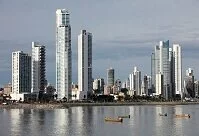Most churches built in colonial Panama reflected the styles of Spain at the time, leading to a large number of Baroque churches. The houses also reflected Spanish housing as many adopted a Spanish Mediterranean style with red tiled roofs.

Panama City
The greatest architectural (or engineering) achievement of the country came in the early 1900s though with the building of the Panama Canal (1880-1914). This canal, primarily built by the Americans altered Panama, and the world, forever as it shortened shipping routes. More importantly it also brought great wealth to the country of Panama.
This wealth has led to greater architectural advancement as the county has the money and resources to build. Both the modern and post-modern architectural styles have arrived in Panama with full force, most particularly in Panama City and in coastal cities.